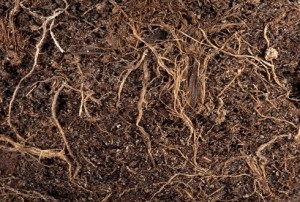The rhizosphere is the narrow region of soil that is directly influenced by associated soil microorganisms and root secretions. The rhizosphere contains many bacteria that feed on sloughed-off plant cells, termed rhizodeposition, and the proteins and sugars released by roots. Protozoa and nematodes that feed on bacteria are also more abundant in the rhizosphere. Thus, much of the nutrient cycling and disease suppression needed by plants occurs immediately adjacent to roots.
The soil outside the rhizosphere is the Bulk soil. Bulk soil is not penetrated by plant roots. Comparitively, natural organic compounds are much lower in bulk soil to the rhizosphere. Microbial populations are typically lower in bulk soil than in rhizospheric soil. Furthermore, bulk soil inhabitants are generally smaller than identical species in the rhizosphere.
Plants secrete many compounds through their roots to associate symbiotically with the rhizosphere. Strigolactones, secreted and detected by mycorrhizal fungi, provoke the germination of spores and initiate changes in the mycorhiza that colonize the root. The parasitic plant, Striga also detects the strigolactones and will germinate when it detects them; they will then move into the root, feeding off the nutrients present. Symbiotic Nitrogen-fixing bacteria, such as Rhizobium species, detect compounds like flavonoids secreted by the roots of leguminous plants and then produce nod factors which signal to the plant that they are present and will lead to the formation of root nodules.
In these nodules bacteria, sustained by nutrients from the plant, convert nitrogen gas to a form that can be used by the plant. Non-symbiotic (or “free-living”) nitrogen-fixing bacteria may reside in the rhizosphere just outside the roots of certain plants (including many grasses), and similarly “fix” nitrogen gas in the nutrient-rich plant rhizosphere. Although it goes beyond the rhizosphere area, it is to note that some plants secrete allelochemicals from their roots which inhibit the growth of other organisms. For example, garlic mustard produces a chemical which is believed to prevent mutualisms forming between the trees and mycorhiza in mesic North American temperate forests.

